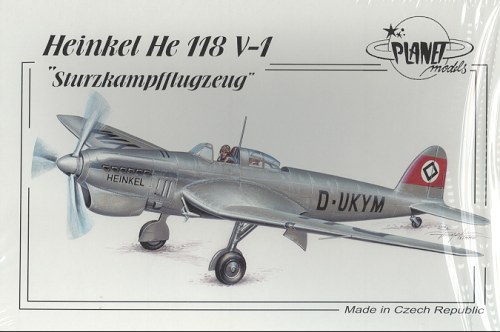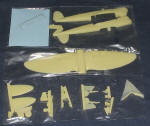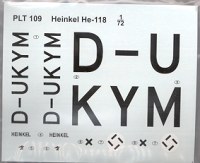
| KIT: | Planet Models 1/72 Heinkel He-118v1 |
| KIT #: | 109 |
| PRICE: | $47.50 MSRP |
| DECALS: | One option |
| REVIEWER: | Scott Van Aken |
| NOTES: | Resin kit with vac canopy |

| HISTORY |
A competitor to the Ju 87, the He 118 proved to be a capable aircraft. However, Junkers was awarded the contract. The V3 prototype was destroyed in an accident in June 1936. V4 and V5 went to the Japanese Army and Navy, respectively. The Japanese Navy's D4Y Suisui is thought to have been loosely based on the 118 as there are a number of similarities between the two. The He 118 V2(1294) made it's mark in history however by being the first aircraft to fly with a turbojet engine powering it, the He S 3a, if only briefly, with the first flight occurring in the summer of 1938. In the buildup to the flight of the He 178, the He 118 was flown on turbojet power alone, it's piston engine being cut off briefly in flight. This would make the He-118v2 the first aircraft to fly solely on turbojet power.
This kit is the original prototype which differed from the other planes in that it was powered by a Rolls Royce Buzzard engine as the DB 600 was not yet available. It also has a shorter fin than the later variants. Despite being superior to Ju-87, the He-118 was not chosen as it could only reach a maximum dive angle of 50 degrees. It didn't help that Ernst Udet's inept piloting crashed the prototype, which basically gave the competition to Junkers.
| THE KIT |
 In
the world of resin kits, Planet Models has to be up at the top of the pile.
They not only offer interesting kits, but the quality of the molding is
superb. They also know how to package thins to help prevent damage. You can
see how this kit has been done from the image to the left. There is a teeny
amount of flash on a few parts and most of the edges of things are slightly
ragged, requiring a brief swipe of sandpaper to remove. There are no air
bubbles, no misshapen parts, no short shots. In fact, the only glitch on
mine is that one of the fuselage halves broke loose from the pour stub and
snapped off the extreme tail. It will be easy to fix. My only real concern
is again, landing gear. These are resin and with a rather hefty chunk of
resin to hold up (as in the solid, single-piece wing), I fear that they
will start to sag after a time.
In
the world of resin kits, Planet Models has to be up at the top of the pile.
They not only offer interesting kits, but the quality of the molding is
superb. They also know how to package thins to help prevent damage. You can
see how this kit has been done from the image to the left. There is a teeny
amount of flash on a few parts and most of the edges of things are slightly
ragged, requiring a brief swipe of sandpaper to remove. There are no air
bubbles, no misshapen parts, no short shots. In fact, the only glitch on
mine is that one of the fuselage halves broke loose from the pour stub and
snapped off the extreme tail. It will be easy to fix. My only real concern
is again, landing gear. These are resin and with a rather hefty chunk of
resin to hold up (as in the solid, single-piece wing), I fear that they
will start to sag after a time.

With only 32 parts, this isn't exactly going to be a difficult kit to build. It has a most complete interior, which sits atop a section in between the wings. There is framing detail on the side walls of the fuselage as well.
Instructions are a single sheet with two construction steps on one side, a history, parts breakdown, and painting guide on the other. The lone prototype is in overall RLM 63 with a red tail band. Actually, I believe the plane is in Lufthansa pearl grey vice RLM 63, but for most of us, the RLM 63 will be close enough. Decals are very well printed and appear to be properly thin. I've never had any troubles with the decals in Planet Models kits.
| CONCLUSIONS |
If your penchant is for the something beyond the norm, or you like Luftwaffe aircraft, or your collection consists of prototypes, then you really should consider this one. The quality of the molding and lack of fiddlyness makes this one a good kit for the first time resin kit builder.
Kit courtesy of me and finding it on sale!
If you would like your product reviewed fairly and fairly quickly by a site that has nearly 300,000 visitors a month, please contact me or see other details in the Note to Contributors.